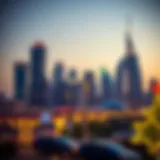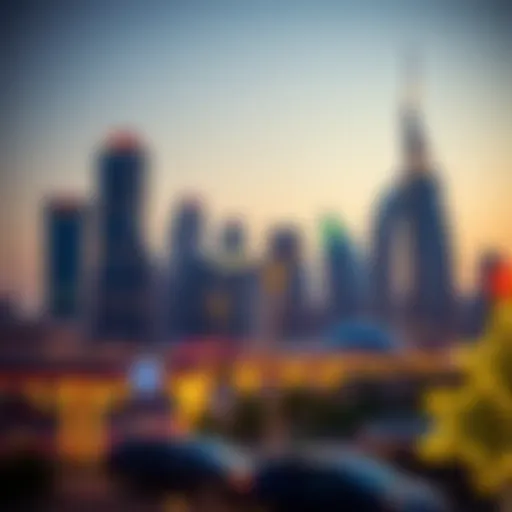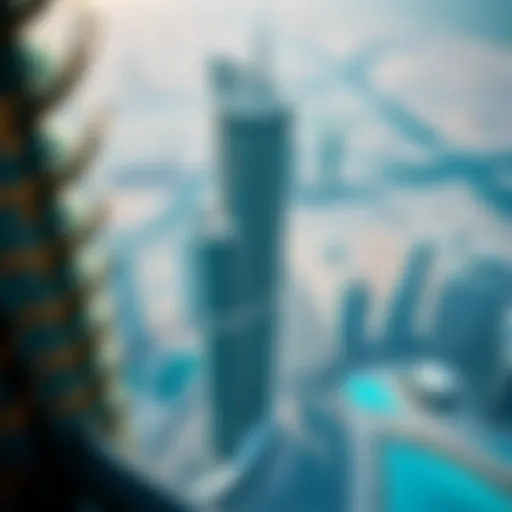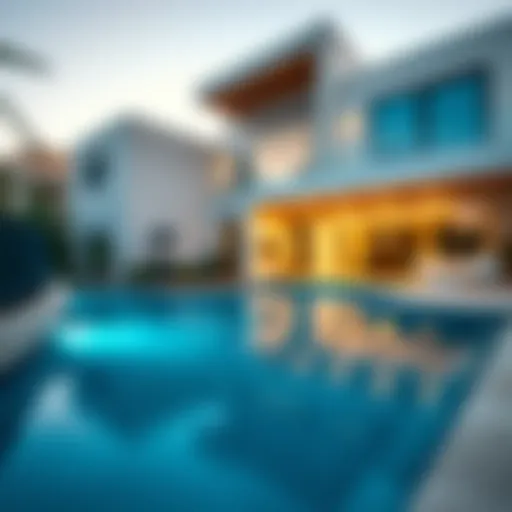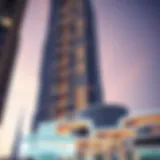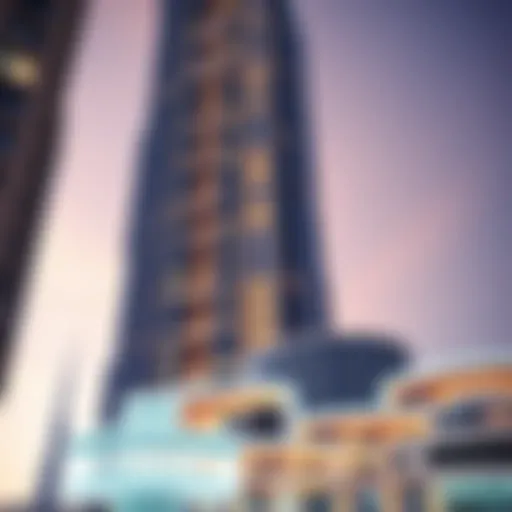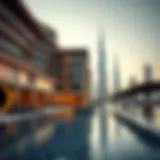Exploring Emirates Towers: Architecture and Photography


Intro
In a city defined by its ever-evolving skyline, the Emirates Towers stand tall, not just as architectural marvels, but as symbols of ambition and innovation. Their impressive facades mirror the pulse of Dubai, a city that seamlessly weaves tradition with modernity. As one gazes at these twin towers, the interplay of steel and glass offers a visual journey that is as much about the buildings as it is about the stories they encapsulate. Photography, in this context, serves as the lens through which we can explore the essence of the Emirates Towers, capturing not only their grandeur but also the vibrant life that unfolds around them.
The towers, completed in 2000, were designed by the renowned architectural firm, Norr Group. Towering above the city's hustle and bustle, these structures host not only offices but also luxury hotels, fostering a blend of work and leisure. The unique silhouette of Emirates Towers, with their striking lines and reflective surfaces, becomes a canvas for photographers—each snapshot revealing an angle or moment that tells a different part of the story.
Exploring the Emirates Towers through the prism of photography allows us to appreciate the architectural significance while delving deep into the cultural narratives that shape the city. From the way sunlight dances off the glass in the early morning to the dynamic street life captured below, each photograph reflects a world where every moment is fleeting, yet immortalized through the click of a shutter.
As we embark on this exploration, it is crucial to recognize the technical and artistic elements of photography that come into play. Factors such as light, composition, and the unique cultural backdrop of Dubai all contribute to the stunning visuals that can emerge from the Emirates Towers.
Thus, the journey ahead will not just be about appreciating the towers themselves, but also understanding how photography can enrich our perspective of one of the world’s most iconic skylines.
Architectural Overview of the Emirates Towers
The Emirates Towers stand as a testament to modern architectural excellence in Dubai. Not merely towering structures of steel and glass, they symbolize the rapid advancements of a city that has emerged as a global hub of business and tourism. This section aims to dissect their significance by examining crucial aspects such as their historical context, unique architectural features, and cultural influences that shape their design.
Historical Context and Design
Established in the late 1990s, the Emirates Towers project was spearheaded by architect Hazel Wong. The towers were completed in 2000, marking a significant milestone in Dubai's urban development. At the time, the skyline was still burgeoning, and the towers quickly became a focal point for not just skyscraper enthusiasts but also urban planners around the world.
The design of the towers reflects a blend of functionality and sophistication. The Emirates Office Tower stretches 355 meters skyward, while the Jumeirah Emirates Towers Hotel reaches slightly less at 309 meters. Both structures employ a sleek, contemporary design that represents Dubai's aspirations. The towers are often compared to the Burj Khalifa but are unique in their own right, integrating cutting-edge technology along with sustainable building practices. They were some of the first skyscrapers to incorporate energy-efficient systems, anticipating a greener approach to architecture long before it became mainstream.
Architectural Features
The Emirates Towers are a marvel of engineering. One cannot help but notice the gleaming glass façade that reflects the vibrant skyline and the desert sun. This design is not accidental; rather, it was meticulously crafted to not only maximize natural light but also reduce energy consumption. The use of double-glazed windows serves a dual purpose: it offers stunning views while also insulating against the oppressive heat.
Some remarkable architectural features include:
- The Diagrid structural framework: It provides strength and stability while allowing for open floor plans. This modern approach offers flexibility in space utilization.
- The sky bridge: Connecting the two towers at a height of 200 meters, it offers panoramic views of the sprawling city below. This feature also serves as a functional area for meetings and events.
- Innovative elevators: Incorporating smart technology, they ensure swift vertical transportation, vital for a busy environment like Dubai.
In essence, these architectural elements combine practicality with aesthetic appeal, creating a landmark that seamlessly integrates with its environment.
Cultural Influences on Design
Culturally, the Emirates Towers draw influence from both traditional Middle Eastern architecture and Western design principles. The towers echo the Islamic architectural motifs through their intricate designs and patterns, reminiscent of the region's rich history while simultaneously exuding a modern flair. This hybrid design approach has become increasingly popular in Dubai, reflecting the city's dual identity rooted in tradition and modernity.
Furthermore, the use of local materials enhances the cultural resonance of the towers. Stone and marble sourced from various regions within the UAE add an authentic touch that honors local craftsmanship. As such, the Emirates Towers are not just a feat of modern architecture; they represent a blend of the old with the new, serving as a bridge between different eras and cultures.
"The Emirates Towers are not simply structures; they are reflective of a changing global landscape, where tradition meets modernity, and innovation thrives."
The architectural overview of the Emirates Towers encapsulates a narrative of ambition, sustainability, and cultural convergence. This thorough understanding serves as a foundation for analyzing the photographic significance of these extraordinary buildings.
For more insight into architectural influences, you may explore resources such as Encyclopedia Britannica or industry discussions on Reddit.
Ultimately, what makes the Emirates Towers unique is not only their height but their ability to tell the story of a city that continues to evolve.
Photographic Significance
The Emirates Towers stand as a testament to modern architectural prowess, intricately woven into the fabric of Dubai's skyline. The significance of photography in capturing the essence of these architectural marvels goes beyond mere representation; it transforms how we perceive and appreciate urban landscapes. The act of photographing structures like the Emirates Towers encapsulates their grandeur, historical context, and cultural relevance while fostering a dialogue between the viewer and the city’s identity. This section will explore two key areas— the role of photography in architecture and the profound impact of visual representation on our understanding of these iconic structures.
Role of Photography in Architecture
Photography serves not just as a tool for documentation but also as a medium for storytelling. When it comes to architectural photography, capturing the Emirates Towers is about more than just pointing a camera and clicking the shutter. Photographers play a crucial role in interpreting the interplay between light and form, allowing viewers to experience the buildings in ways that words often cannot articulate.
The innovative designs of the Emirates Towers, characterized by their sleek lines and reflective surfaces, are highlighted through various photographic techniques. Here are some key points regarding photography's role in architecture:
- Immortalizing Design: Great architecture deserves to be showcased. Photographs can freeze a moment in time, preserve unique designs, and highlight the thought processes behind architectural choices.
- Contextual Relevance: Images help situate buildings within their environment. This aspect illustrates how the Towers interact with the surrounding landscape, providing insight into their architectural significance in Dubai.
- Inspirational Perspective: For architects and designers, studying high-quality images of structures can inspire new ideas and concepts, igniting creativity and innovation.
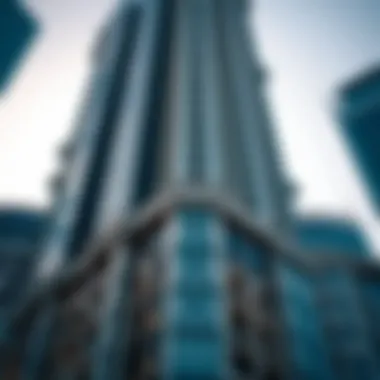

Photography breathes life into architecture by allowing viewers to engage with the Emirates Towers not just visually, but emotionally. The allure is palpable, creating a deeper connection with the observer.
Impact of Visual Representation
Visual representation shapes public perception, influencing our emotions and reactions towards landmarks like the Emirates Towers. Every image tells a story, and how we choose to frame that narrative can either enhance or dilute the architecture's significance.
Here are several ways in which visual representation impacts our understanding of the Emirates Towers:
- Cultural Identity: Photographs of the towers often embody Dubai’s dynamic blend of tradition and modernity. They act as symbols of the city's rapid growth and development, all while reflecting the cultural heritage that underpins urban progress.
- Emotional Engagement: The right angle, light, and composition can evoke feelings of awe or admiration. Iconic photographs can create a sense of place and belonging, making viewers feel part of the narrative of Dubai.
- Digital Presence: In today’s digital age, social media platforms amplify the reach of photographs, making them essential for marketing and brand recognition. Images shared online shape how potential investors or tourists perceive Dubai.
"A picture is worth a thousand words, but for the Emirates Towers, it can represent an entire dialogue about urban culture and identity."
To sum it up, while the Emirates Towers grace the skyline with their architectural brilliance, photography magnifies their impact. This transformative medium enhances our appreciation, telling stories that resonate with diverse audiences, from investors to the average tourist. Understanding these dynamics is crucial as we navigate the complex landscape of contemporary architecture and its representation.
Techniques in Capturing Emirates Towers
Capturing the essence of Emirates Towers through photography requires more than just pointing and shooting. The techniques employed in photography play a pivotal role in portraying the towers not just as structures, but as narratives interwoven into the fabric of Dubai's identity. Each photograph tells a story that reflects not only the subject but also the photographer's unique perspective, making the choice of technique vital.
Use of Natural Light
Natural light is arguably the most crucial element when photographing Emirates Towers. The towers are designed to reflect and interact with light in striking ways. Golden hour, occurring shortly after sunrise and before sunset, transforms the towers, casting soft shadows and illuminating their glass facades with warm hues. Photographers should aim to capture this fleeting moment to emphasize the dynamic nature of the structures.
Moreover, the time of day significantly impacts the mood and feel of the photographs. During the day, the harsh noon sunshine can create stark contrasts, emphasizing architectural lines and details. In contrast, twilight adds a dramatic flair, allowing the towers to glow against the dimming sky. Knowing when to shoot is integral.
- Tips for using natural light:
- Scout locations ahead of time to determine the best angles for light
- Consider using reflectors to bounce light into shadowed areas, enhancing detail
- Be patient with changing conditions; clouds or weather shifts can create unexpected visual dramas
Composition and Angles
Composition involves arranging all visual elements within the frame to form a cohesive image. When photographing Emirates Towers, it's essential to think about how every aspect from foreground to background contributes to the overall story.
Different angles can yield varied representations of the towers. For example, shooting from below can give the structures an imposing presence, while capturing them from an aerial view might showcase Dubai’s vast cityscape which cradles them.
- Key composition techniques:
- Rule of Thirds: Place the towers off-center to create more visual tension and interest
- Leading Lines: Use pathways or streets as lines that direct the viewer's eye towards the towers
- Framing: Utilize surrounding elements like trees or other buildings to frame the towers, adding depth and focus
In this manner, photographers can effectively communicate messages about grandeur, innovation, and the relationship between the towers and the city around them.
Camera Equipment and Settings
The choice of equipment and settings plays a critical role in capturing Emirates Towers in their full glory. While it’s true that the most expensive gear won’t guarantee great photos, understanding how to utilize your equipment is key. For most photographers, a DSLR or mirrorless camera is ideal due to their flexibility and performance.
When it comes to lenses, a wide-angle lens can be particularly effective for architectural photography, as it allows you to capture the height and scale of the towers. Here are some settings and tips:
- Aperture: Use a lower f-stop (like f/8 to f/11) for deeper depth of field which keeps both the foreground and background in focus.
- Shutter Speed: A slower shutter speed may be necessary in low light, especially during twilight or night shoots. This also might require a tripod.
- ISO: Keep ISO low (around 100-200) to prevent noise, especially during bright daylight.
Photographers should also review their equipment setup before heading out. Missing a vital cable or a charged battery can spell disaster.
Symbolism in the Photographs
Exploring the Emirates Towers through the lens of photographers unveils a captivating dialogue between visuals and meanings. The photographs do more than capture mere structures; they encapsulate the essence of modernity, tradition, and the urban experience. This section illuminates the intricate symbolism found within these images, discussing how they provoke thought and reveal deeper cultural narratives.
Reflection of Modernity and Tradition
In the bustling city of Dubai, the Emirates Towers stand tall as a testament to progress. The juxtaposition of sleek glass facades with elements reminiscent of traditional Islamic art creates a striking balance that symbolizes the blend of old and new.
- Glass and Steel: The reflective surfaces of the towers echo the sky, suggesting a connection to the future while also encapsulating the heritage of the region. Photography captures this duality, showcasing the surreal contrast between contemporary architecture and historical inspirations.
- Cultural Patterns: The intricate patterns displayed on the buildings' surfaces speak volumes. Photographers often frame their shots to highlight these elements, inviting viewers to ponder their significance. They hint at the rich history of artistry that influences modern design, serving as a reminder that tradition plays a vital role in shaping the skyline.
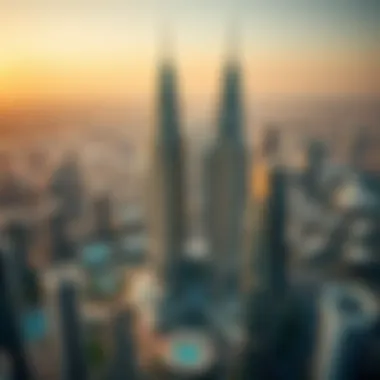

The photographs reflect modernity not merely as advancement but as a dialogue with tradition. When capturing the Emirates Towers, photographers often play with angles, shadows, and light to convey this ongoing conversation, compelling the audience to reconsider the relationship between the structures and the people who interact with them.
Narratives of Urban Life
Every click of the shutter at the Emirates Towers tells a story beyond the architectural splendor. The urban life surrounding these iconic landmarks unfolds through various photographic lenses.
- Everyday Moments: Images freeze everyday interactions—strollers by the fountains, workers hurrying along the pavement, and visitors marveling at the towers. These photographs weave a tapestry of Dubai's fast-paced life, reflecting dreams, aspirations, and the hustle that cities embody.
- Social Interactions: Photographers often focus on the diverse population that inhabits the spaces around the Emirates Towers. Their photos capture laughter, conversations, and the vibrant cultures that come together in this urban setting. Each frame holds a narrative of coexistence amidst the city's chaos, presenting a mosaic of human experiences.
The urban narratives captured through photography create a sense of place that goes beyond concrete and glass. It fosters an understanding of how the Emirates Towers serve as a backdrop to the stories of countless individuals, linking their personal journeys to the architectural symbols of resilience and ambition.
By showcasing these facets of life, photographers offer a lens into the heart of Dubai, shaping how we perceive urban landscapes and redefining what it means to inhabit a modern city.
Case Studies: Notable Photographs
In the context of the Emirates Towers, case studies of notable photographs serve as vivid windows into the architectural beauty and cultural narratives woven through this iconic landmark. These photographs are not just still images; they encapsulate moments that reflect the towers’ interplay with light, the surrounding landscape, and the vibrancy of urban life. Analyzing these selected works offers deeper insights into how photography shapes our understanding of architecture and instills a sense of place in viewers.
Whether shot at twilight with the towers shimmering against a backdrop of a fading sun or during a bustling daytime event, each photograph conveys a unique story and emotional resonance, inviting viewers to explore beyond their façades. This section delves into three key elements of notable photographs: day vs. night, seasonal perspectives, and panoramic views, each displaying distinct characteristics and techniques that highlight the Emirates Towers in compelling ways.
Day vs. Night Photography
Day and night offer contrasting canvases for photographers aiming to capture the essence of the Emirates Towers. During daytime, the structure can be enlivened by the sun’s rays, showcasing its glass and steel surfaces that reflect the surrounding cityscape. The azure sky often creates a vivid backdrop, illustrating a modern marvel against a traditionally arid landscape. Shots taken from ground level often highlight the towers' towering stature, emphasizing their dominance over the skyline of Dubai.
Night photography, on the other hand, transforms the towers into glowing beacons of light, neatly housed within a blanket of darkness. The glowing glass facades, coupled with the strategic city lights, bring forth a lively atmosphere. This juxtaposition can capture scenes bustling with nightlife while immersing the viewer into a more serene narrative of architectural beauty. Exploring the methodologies behind both forms of photography not only enriches the visual experience but also enhances understanding of light's role in architecture.
Seasonal Perspectives
When it comes to photographing Emirates Towers, changing seasons undeniably influence the perception of the architectural gem. Each season sheds a different light—figuratively and literally—on its design elements, textures, and surrounding contexts. For instance, the summer months often envelop the towers in a hazy warmth, where the sun casts long shadows that delicately graze the surfaces.
Conversely, post-rain shots offer a richly saturated view, showcasing reflections that dance across puddles. The towers stand resilient, reflecting the resilience and modernity of Dubai. Moreover, seasonal events, such as New Year's Eve fireworks, significantly enrich photographs taken during these times. Special occasions imbue the images with a sense of festivity and vivacity that day-to-day photographs may lack, allowing for storytelling through imagery that not only captures buildings but cultures.
Panoramic Views
Panoramic photography provides a sweeping visual narrative, particularly beneficial when capturing the Emirates Towers in relation to their surroundings. These shots grant viewers an expansive overview, enabling them to glimpse the interplay between the towers and the rest of Dubai’s skyline, with additional architectural marvels dotting the horizon.
Utilizing wide-angle lenses, photographers can amplify the grandeur of the Emirates Towers, accentuating their role in defining the skyline's character. Some of the most powerful panoramic shots incorporate elements such as the bustling promenade or serene waters of the Arabian Gulf, creating a sense of duality between urban life and natural beauty. These compositions not only exhibit technical expertise but also evoke feelings of wonder and exploration, showcasing the architectural splendor where policies of modernism and tradition harmoniously collide.
Importance of Case Studied Photographs
"Understanding photographic perspectives contributes significantly to how we visualize and interpret iconic architectural structures such as the Emirates Towers. Each image becomes a narrative thread, weaving together visual storytelling with cultural significance."
Through exploring these aspects, case studies on the Emirates Towers reveal a multifaceted tapestry of narratives waiting to be captured and told. It emphasizes that with photography, exposure becomes more than mere light and shadow—it’s the capture of stories awaiting to resonate with those who view them.
The Role of Social Media
Social media has become a force to reckon with in today’s communication landscape, shaping interactions and opinions in ways that were unimaginable a few decades ago. When it comes to architectural monuments like the Emirates Towers, the influence of social media can't be overstated. It plays a pivotal role in how these structures are perceived globally, altering not just the narrative around them but also their cultural significance.
The visual-centric nature of platforms such as Instagram, Pinterest, and Facebook amplifies the architectural beauty of Emirates Towers. Each photograph shared captures not just the visual aesthetic of these skyscrapers, but also the interwoven stories of the city beneath them. With every click, users engage with the towers in more personal ways, often sharing their own experiences and interpretations of the landmarks.
Influence on Popular Perception
The power of social media to sway popular opinion is profound. Photographs of the Emirates Towers aren't merely structures in a skyline; they become symbols of aspiration, luxury, and innovation. The way these images are shared often distills the grandeur of Dubai into digestible content for international audiences. Through hashtags and geotags, users often create an informal, yet potent narrative around the towers, reinforcing their status as must-visit landmarks.
Here are some ways social media influences the perception of Emirates Towers:
- Visibility: With millions of users worldwide posting their captures, Emirates Towers maintains a high level of visibility, attracting potential tourists and investors alike.
- Context: Users often share anecdotes alongside pictures, providing a narrative that connects viewers to the space. This context can include personal stories or even cultural insights into Dubai.
- Aspirational Living: The images often project a lifestyle that many aspire to, framing the towers not just as buildings but as beacons of an affluent lifestyle.
The essence of a place is often captured through the lens of those who experience it. Social media serves as a conduiit for this essence, allowing the Emirates Towers to remain in the global conversation.
Photographic Trends and Styles
In the expansive world of social media, trends shift faster than the desert sands outside the Emirates Towers. Photographers, whether amateur or professional, are constantly innovating how they approach capturing these iconic structures. Awareness of online trends not only aids photographers in crafting visually captivating imagery but also influences how these images are perceived by the audience.
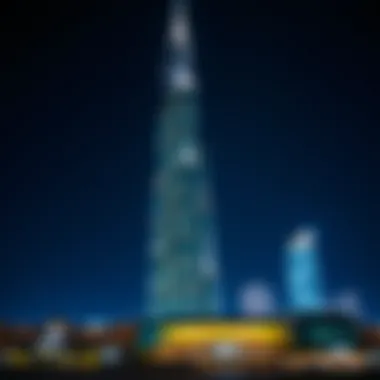

Popular photographic styles that resonate on social media include:
- Minimalism: This trend highlights the elegant lines of Emirates Towers against the vastness of the sky, often removing extraneous elements to create a striking visual impact.
- Night Photography: With the towers illuminated against the night sky, photographers often celebrate the juxtaposition of modernity and tradition through long exposure shots, capturing both the beauty and vibrancy of Dubai nightlife.
- Drone Photography: Aerial shots provide a unique perspective, showcasing the towers as part of a broader urban landscape, revealing connections to other iconic structures and the bustling life around them.
Through these varying styles, photos taken and shared on social media not only enhance the allure of the Emirates Towers but also encourage a more profound exploration of Dubai's architectural marvels. Each post becomes a chapter in the ongoing story of this grand edifice, further building its legend in the minds of viewers around the world.
The impact of social media on the Emirates Towers extends beyond just popular perception; it is integral to how these structures are appreciated and understood in a global context.
Emirates Towers: Beyond the Lens
Understanding the Emirates Towers goes beyond the aesthetic appeal they provide. It highlights the intricate balance between architecture and photography, revealing how these elements come together to narrate a larger story about Dubai's skyline. Each photograph taken is not just a visual representation but a gateway into the cultural, historical, and architectural significance of this landmark. This section dives into the profound effects of the Emirates Towers on the architectural landscape of Dubai and how they engage visitors in unique and meaningful ways.
The essence of the Emirates Towers can be captured through various lenses, quite literally and metaphorically. By exploring their architectural impact and the experience they offer to visitors, we can fathom why these towers are not merely structures but embodiments of the spirit of modern Dubai.
Architectural Impact on Dubai's Skyline
The Emirates Towers are critical markers in Dubai's architectural heritage, reshaping how the world perceives this vibrant city. Rising majestically against the backdrop of the Arabian desert, they redefine the skyline with boldness and elegance. The towers’ form echoes the aspirations of a city that continually pushes boundaries.
Their sleek glass façades reflect sunlight and the dynamic energy of the city below, creating an ever-changing tapestry of light that captivates both residents and visitors. Each time you catch a glimpse of Emirates Towers, whether it’s emerging from a taxi or from the terrace of a nearby coffee shop, it's hard not to notice how they command attention.
- Landmark Status: They represent a crucial phase in Dubai's rapid evolution, marking the transition from traditional landscapes to ultramodern urban aesthetics.
- Influence on Future Developments: The design philosophy behind Emirates Towers has laid the groundwork for subsequent constructions, influencing architects to embrace more sustainable and innovative practices.
"The Emirates Towers are not just skyscrapers; they symbolize Dubai's ambition and relentless pursuit of progress."
Their superb design is not just about looking good. Many architects and city planners view the Emirates Towers as exemplars of integrating functionality with artistic expression. They facilitate business and leisure, drawing investors and tourists alike to marvel at their beauty and utility.
Visitor Experience and Interactions
When speaking of the Emirates Towers, it is essential to touch on how they create immersive experiences for the millions who visit year-round. These buildings do more than stand tall; they engage people in ways that leave lasting impressions. From the moment one steps into the elegantly designed lobby, the ambiance shifts. Visitors are enveloped by a sense of opulence paired with modernist simplicity.
- Interactivity: The engaging art installations that adorn the premises invite guests to interact with Dubai’s culture and heritage.
- Experiential Activations: Events and exhibitions frequently take place, showcasing local artists and new technologies, encouraging visitors to participate rather than observe from a distance.
Photography enthusiasts revel in the varied angles and moments that the Emirates Towers provide. It's not uncommon to see people maneuvering to take the perfect shot at sunset, capturing the towers basking in golden hour light or shrouded in the evening's dim glow. The interplay of light and shadow on their surfaces tells ongoing stories about the city and allows each visitor to partake in crafting personal narratives through their photographs.
In essence, the Emirates Towers are more than structural entities; they stand as dynamic platforms for architectural appreciation and cultural exchange, beckoning visitors to engage in a deeper dialogue with their surroundings.
Ends and Future Photographic Endeavors
The exploration of Emirates Towers through photographic perspectives not only highlights the towers' architectural brilliance but also opens discussions on future photographic pursuits. As the visual embodiment of Dubai’s steadfast progress, both the Emirates Towers and the photographs that encapsulate them serve as a bridge between the past and the future. Understanding these connections is essential for various audiences, from investors to architects, as it informs them about the evolving nature of urban landscapes and design philosophy.
Photographs of Emirates Towers do much more than display a breathtaking image; they tell stories that underscore the cultural and societal shifts occurring in Dubai. Each snapshot can represent the aspirations, dreams, and realities of urban living. This article has delved deep into how light, angle, and composition play crucial roles in conveying these narratives, thereby enhancing the appreciation of this iconic structure.
Summarizing Insights
The interplay between architecture and photography particularly shines in the context of Emirates Towers. The dual-focus not only emphasizes the towers as a key player in Dubai's skyline but also their role as subjects within the art of photography. Key insights include:
- Architectural fluency: The design and construction of Emirates Towers reflect a blend of avant-garde and traditional elements, which photographers can skillfully highlight through various techniques.
- Cultural narratives: How the towers stand as symbols of modernity intertwined with cultural resonance is distinctly captured through thoughtful photographic choices.
- Technological evolution: The advancement in camera technology parallels the modern construction methods of the towers, suggesting that both are continuously evolving to achieve greater precision and creativity.
As future photographers embark on capturing this landmark, they should consider the dimensions beyond mere aesthetics. The context of the shots, time of day, and even the emotional weight of the moment can elevate the visual experience and storytelling potential markedly.
Encouraging Creative Exploration
Encouraging creative exploration around Emirates Towers involves not just improving technical skills but also nurturing an artistic sensibility that appreciates context and narrative. Here are some aspects to consider:
- Diverse Perspectives: Photographers should experiment with unconventional angles or viewpoints to reinterpret Emirates Towers in ways that may have not been shown before.
- Environmental Context: Including surrounding landscapes or urban elements in photographic compositions can contrast the towers’ sleekness against the bustling life of Dubai, offering deeper insights into urban dynamics.
- Temporal Experimentation: Capturing the towers at different times, such as during sunrise or twilight, can produce varying moods and tones. Each moment tells a unique narrative that can resonate differently with viewers.
- Digital Storytelling: As social media platforms continue to shape public perception, merging traditional photography with digital storytelling can create immersive experiences for audiences. This approach offers a broader interpretation of how Emirates Towers fit into the modern tableau of Dubai.
In a nutshell, the visually striking Emirates Towers beg to be photographed from fresh angles and perspectives. As photographers venture into experimenting with styles and narratives, they contribute to a legacy of art that celebrates the tower and its importance in the context of Dubai's architectural narrative.
"Every photograph is a story; let us ensure that ours tell of beauty, complexity, and evolution."
Resources for Further Learning
- Wikipedia - Emirates Towers
- Britannica - Dubai
- Reddit - Photography
- Government of Dubai - Tourism
- Facebook - Emirates Towers Page
This journey of exploring Emirates Towers through photography is far from over. It’s an invitation to photographers and enthusiasts alike to pick up their cameras and find their narratives amidst the silhouettes of this magnificent structure.


